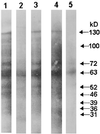Differential decline in Leishmania membrane antigen-specific immunoglobulin G (IgG), IgM, IgE, and IgG subclass antibodies in Indian kala-azar patients after chemotherapy
- PMID: 10569788
- PMCID: PMC97080
- DOI: 10.1128/IAI.67.12.6663-6669.1999
Differential decline in Leishmania membrane antigen-specific immunoglobulin G (IgG), IgM, IgE, and IgG subclass antibodies in Indian kala-azar patients after chemotherapy
Abstract
Pathogenesis in kala-azar is associated with depressed cellular immunity and significant elevation of antileishmanial antibodies. Since these antibodies are present even after cure, analysis of the parasite-specific isotypes and immunoglobulin G (IgG) subclasses in kala-azar patients may shed new light on the immune responses during progression and resolution of infection. Using leishmanial membrane antigenic extracts, we investigated the relative levels of specific IgG, IgM, IgA, IgE, and IgG subclasses in Indian kala-azar patient sera during disease, drug resistance, and cure. Acute-phase sera showed strong stimulation of IgG, followed by IgE and IgM and lastly by IgA antibodies. IgG subclass analysis revealed expression of all of the subclasses, with a predominance of IgG1 during disease. Following sodium stibogluconate (SAG) resistance, the levels of IgG, IgM, IgE, and IgG4 remained constant, while there was a decrease in the titers of IgG2 and IgG3. In contrast, a significant (2.2-fold) increase in IgG1 was observed in these individuals. Cure, in both SAG-responsive and unresponsive patients, correlated with a decline in the levels of IgG, IgM, IgE, and all of the IgG subclasses. The stimulation of IgG1 and the persistence, most importantly, of IgE and IgG4 following drug resistance, along with a decline in IgE, IgG4, and IgG1 with cure, demonstrate the potential of these isotypes as possible markers for monitoring effective treatment in kala-azar.
Figures





Similar articles
-
Characterization of immunoglobulin G and its subclass response to Indian kala-azar infection before and after chemotherapy.Infect Immun. 2004 Feb;72(2):863-70. doi: 10.1128/IAI.72.2.863-870.2004. Infect Immun. 2004. PMID: 14742530 Free PMC article.
-
Immunoglobulin subclass distribution and diagnostic value of Leishmania donovani antigen-specific immunoglobulin G3 in Indian kala-azar patients.Clin Diagn Lab Immunol. 1999 Mar;6(2):231-5. doi: 10.1128/CDLI.6.2.231-235.1999. Clin Diagn Lab Immunol. 1999. PMID: 10066659 Free PMC article.
-
Distribution of IgG subclasses in antimonial unresponsive Indian kala-azar patients.Clin Exp Immunol. 1998 Dec;114(3):408-13. doi: 10.1046/j.1365-2249.1998.00752.x. Clin Exp Immunol. 1998. PMID: 9844051 Free PMC article.
-
Treatment of visceral leishmaniasis (kala-azar): a decade of progress and future approaches.Int J Infect Dis. 2000;4(3):158-77. doi: 10.1016/s1201-9712(00)90078-x. Int J Infect Dis. 2000. PMID: 11179920 Review.
-
Drug unresponsiveness & combination therapy for kala-azar.Indian J Med Res. 2006 Mar;123(3):389-98. Indian J Med Res. 2006. PMID: 16778318 Review.
Cited by
-
Characterization of immunoglobulin G and its subclass response to Indian kala-azar infection before and after chemotherapy.Infect Immun. 2004 Feb;72(2):863-70. doi: 10.1128/IAI.72.2.863-870.2004. Infect Immun. 2004. PMID: 14742530 Free PMC article.
-
High levels of serum glycans monovalent IgG immune complexes detected by dissociative ELISA in experimental visceral leishmaniasis.Immunology. 2019 Dec;158(4):314-321. doi: 10.1111/imm.13118. Epub 2019 Oct 1. Immunology. 2019. PMID: 31576564 Free PMC article.
-
Systematic review of biomarkers to monitor therapeutic response in leishmaniasis.Antimicrob Agents Chemother. 2015 Jan;59(1):1-14. doi: 10.1128/AAC.04298-14. Epub 2014 Nov 3. Antimicrob Agents Chemother. 2015. PMID: 25367913 Free PMC article.
-
Detection of anti-leishmania (Leishmania) chagasi immunoglobulin G by flow cytometry for cure assessment following chemotherapeutic treatment of American visceral leishmaniasis.Clin Vaccine Immunol. 2007 May;14(5):569-76. doi: 10.1128/CVI.00354-06. Epub 2007 Mar 14. Clin Vaccine Immunol. 2007. PMID: 17360851 Free PMC article. Clinical Trial.
-
Murine visceral leishmaniasis: IgM and polyclonal B-cell activation lead to disease exacerbation.Eur J Immunol. 2010 May;40(5):1355-68. doi: 10.1002/eji.200939455. Eur J Immunol. 2010. PMID: 20213734 Free PMC article.
References
-
- Abbas A K, Murphy K M, Sher A. Functional diversity of helper T lymphocytes. Nature. 1996;383:787–793. - PubMed
-
- Afrin F, Ali N. Isotype profiles of Leishmania donovaniinfected BALB/c mice: preferential stimulation of IgG2a/b by liposome associated promastigote antigens. J Parasitol. 1998;84:743–748. - PubMed
-
- Ali N, Afrin F. Protection of mice against visceral leishmaniasis by immunization with promastigote antigen incorporated in liposome. J Parasitol. 1997;83:70–75. - PubMed
Publication types
MeSH terms
Substances
LinkOut - more resources
Full Text Sources
Miscellaneous

